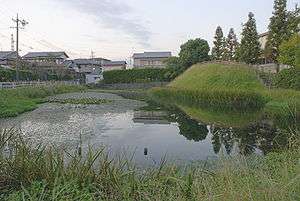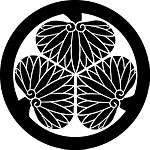Tanaka Domain

Tanaka Domain (田中藩 Tanaka-han) was a feudal domain under the Tokugawa shogunate of Edo period Japan, located in Suruga Province in what is now modern-day Fujieda, Shizuoka.[1] Tanaka Domain was controlled by a large number of daimyō families in the course of its history, seldom for more than one generation.
History
Nakamura Kazutada, a retainer of Toyotomi Hideyoshi and castellan of Sumpu Castle built Tanaka Castle as a subsidiary fortification guarding the eastern approaches to Sumpu. After the defeat of the Toyotomi forces at the Battle of Sekigahara, he was relocated to Yonago by the victorious Shōgun Tokugawa Ieyasu. Ieyasu kept Sumpu Castle for himself, and gave Tanaka Castle to his retainer Sakai Tadatoshi in 1601, with revenue of 10,000 koku. This marked the start of Tanaka Domain. Tadatoshi developed Fujieda-juku into a post station on the Tōkaidō, and as a castle town. He was so successful in his efforts that he was rewarded with a larger domain at Kawagoe in Musashi province in 1607, and Tanaka Domain reverted to direct Shogunal control.
Tanaka Domain was then given to Matsudaira (Sakurai) Tadashige, with its revenues increased to 25,000 koku in 1633. However, Tadashige was transferred to Kakegawa two years later, and his place was taken Mizuno Tadayoshi, with revenues of 45,000 koku. The Mizuno clan was subsequently replaced by the Matsudaira (Fujii), Hōjō, Nishio, Sakai, Tsuchiya, Ōta, Naitō, and Toki clans until Tanaka Domain finally came under the rule of the Honda clan in 1730. The Honda continued to rule Tanaka Domain over seven generations, until the Meiji Restoration of 1868. After the final Tokugawa Shōgun, Tokugawa Yoshinobu, surrendered his title to Emperor Meiji, he relocated from Edo to Sumpu, with the provinces of Suruga, Izu and Mikawa as his personal domains. Tanaka Domain was included within the area of the new Shizuoka Domain. Thus, in September 1868, Tanaka Domain officially ceased to exist. The final daimyō of Tanaka Domain, Honda Masamori, received the new (and short-lived) domain of Nagao Domain in Awa province in exchange.
Holdings at the end of the Edo period
As with most domains in the han system, Tanaka Domain consisted of several discontinuous territories calculated to provide the assigned kokudaka, based on periodic cadastral surveys and projected agricultural yields.[2][3]
- Shimōsa Province
- 33 villages in Katsushika District
- 10 villages in Soma District
- Suruga Province
- 6 villages in Suntō District
- 57 villages in Shida District
- 20 villages in Mashizu District
List of daimyo
# Name Tenure Courtesy title Court Rank kokudaka  Sakai clan, 1601-1609 (fudai)[4]
Sakai clan, 1601-1609 (fudai)[4]1 Sakai Tadatoshi (酒井 忠利)[4] 1601–1607 Bungo-no-kami (備後守) Lower 5th (従五位下) 10,000 koku  tenryō 1607-1635
tenryō 1607-1635 Matsudaira (Sakurai) clan, 1633-1635 (fudai)[1]
Matsudaira (Sakurai) clan, 1633-1635 (fudai)[1]1 Matsudaira Tadashige (松平 忠重) 1633–1635 Daizen-no-suke (大膳亮) Lower 5th (従五位下) 25,000 koku  Mizuno clan, 1535-1642 (fudai)[1]
Mizuno clan, 1535-1642 (fudai)[1]1 Mizuno Tadayoshi (水野 忠善) 1635–1642 Daikenmotsu (大監物) Lower 5th (従五位下) 45,000 koku  Matsudaira (Fujii) clan, 1642-1644 (fudai)[1]
Matsudaira (Fujii) clan, 1642-1644 (fudai)[1]1 Matsudaira Tadaharu (松平 忠晴) 1642–1644 Iga-no-kami (伊賀守) Lower 5th (従五位下) 25,000 koku  Hōjō clan, 1644-1648 (tozama)[1]
Hōjō clan, 1644-1648 (tozama)[1]1 Hōjō Ujishige (北条 氏重) 1644–1648 Dewa-no-kami ( 出羽守) Lower 5th (従五位下) 25,000 koku  Nishio clan, 1648-1679 (fudai)[1]
Nishio clan, 1648-1679 (fudai)[1]1 Nishio Tadateru (西尾 忠照) 1649–1654 Tango-no-kami (丹後守) Lower 5th (従五位下) 25,000 koku 2 Nishio Tadanari (西尾 忠成) 1654–1679 Oki-no-kami (隠岐守) Lower 5th (従五位下) 25,000 koku  Sakai clan, 1679-1681 (fudai)[1]
Sakai clan, 1679-1681 (fudai)[1]1 Sakai Tadayoshi (酒井 忠能) 1679–1681 Hyuga-no-kami(日向守) Lower 5th (従五位下) 40,000 koku  Tsuchiya clan, 1681-1684 (fudai)[1]
Tsuchiya clan, 1681-1684 (fudai)[1]1 Tsuchiya Masanao (土屋 政直) 1681–1684 Sagami-no-kami (相模守); Jiju (侍従) Lower 5th (従五位下) 45,000 koku  Ōta clan, 1684-1705 (fudai)[1]
Ōta clan, 1684-1705 (fudai)[1]1 Ōta Sukenao (太田 資直) 1684–1705 Settsu-no-kami (摂津守) Lower 5th (従五位下) 50,000 koku 2 Ōta Sukeharu (太田 資晴) 1705 Bitchu-no-kami (備中守) Lower 4th (従四位下) 50,000 koku  Naitō clan, 1705-1712 (fudai)[1]
Naitō clan, 1705-1712 (fudai)[1]1 Naitō Kazunobu (内藤弌信) 1705–1720 Bizen-no-kami (豊前守) Lower 4th (従四位下) 50,000 koku  Toki clan, 1712-1730 (fudai)[1]
Toki clan, 1712-1730 (fudai)[1]1 Toki Yoritaka (土岐頼殷) 1712–1713 Iyo-no-Kami (伊予守) Lower 4th (従四位下) 35,000 koku 2 Toki Yoritoshi (土岐頼稔) 1713–1742 Tango-no-kami (丹後守); Jiju (侍従) Lower 4th (従四位下) 35,000 koku  Honda clan, 1730-1868 (fudai)[1]
Honda clan, 1730-1868 (fudai)[1]1 Honda Masanori (本多正矩) 1730–1735 Bizen-no-kami (豊前守) Lower 5th (従五位下) 40,000 koku 2 Honda Masayoshi (本多正珍) 1735–1773 Hoki-no-kami (伯耆守) Lower 4th (従四位下) 40,000 koku 3 Honda Masatomo (本多正供) 1773–1777 Kii-no-kami (紀伊守) Lower 5th (従五位下) 40,000 koku 4 Honda Masaharu (本多正温) 1777–1800 Hoki-no-kami (伯耆守) Lower 5th (従五位下) 40,000 koku 5 Honda Masaoki (本多正意) 1800–1829 Totomi-no-kami (遠江守) Lower 5th (従五位下) 40,000 koku 6 Honda Masahiro (本多正寛) 1829–1850 Totomi-no-kami (遠江守) Lower 5th (従五位下) 40,000 koku 7 Honda Masamori (本多正訥) 1850–1868 Kii-no-kami (紀伊守) Lower 5th (従五位下) 40,000 koku
See also
References
- 1 2 3 4 5 6 7 8 9 10 11 12 "Suruga Province" at JapaneseCastleExplorer.com; retrieved 2013-4-10.
- ↑ Mass, Jeffrey P. and William B. Hauser. (1987). The Bakufu in Japanese History, p. 150.
- ↑ Elison, George and Bardwell L. Smith (1987). Warlords, Artists, & Commoners: Japan in the Sixteenth Century, p. 18.
- 1 2 Papinot, Jacques Edmond Joseph. (1906). Dictionnaire d’histoire et de géographie du Japon; Papinot, (2003). "Sakai" at Nobiliare du Japon, p. 51; retrieved 2013-8-8.
External links
- "Tanaka" at Edo 300 (Japanese)